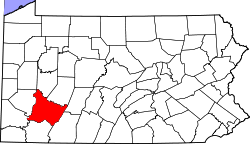North Huntingdon, Pennsylvania
| North Huntingdon Township, Westmoreland County, Pennsylvania |
|
|---|---|
| Township | |

The Fullerton Inn, a historic site in the township
|
|
 Map of Westmoreland County, Pennsylvania Highlighting North Huntingdon Township |
|
 Map of Pennsylvania highlighting Westmoreland County |
|
| Country | United States |
| State | Pennsylvania |
| County | Westmoreland |
| Area | |
| • Total | 27.4 sq mi (71 km2) |
| • Land | 27.3 sq mi (71 km2) |
| • Water | 0.1 sq mi (0.3 km2) |
| Population (2015) | |
| • Total | 30,763 |
| • Density | 1,121.2/sq mi (432.9/km2) |
| Time zone | Eastern (EST) (UTC-5) |
| • Summer (DST) | EDT (UTC-4) |
North Huntingdon Township is a township in Westmoreland County, Pennsylvania, USA. The population was 30,609 at the 2010 census.
Named after England’s Earl of Huntingdon, Huntingdon Township was founded on April 6, 1772 in Pennsylvania.
Huntingdon’s boundaries started at the mouth of Brush Run where it emptied into Brush Creek. The area is approximately 26 square miles (67 km2)with the Township maintaining about 125 miles (200 km)of roads. If these roads were placed end-to-end, they would stretch from North Huntingdon to Cleveland, Ohio. The boundaries, following along Byerly’s Path to Braddock Road, continued to the lines that mark Mount Pleasant, Tyrone and Pitt Townships. Huntingdon Township was later divided into the townships North Huntingdon, East Huntingdon, South Huntingdon and Sewickley. Around this same time, Westmoreland County, where North Huntingdon is located, became the townships of Fairfield, Donegal, Mount Pleasant, Hempfield, Pitt, Tyrone, Springhill, Menallen, Rostraver and Armstrong.
Many Native American tribes inhabited this area before the European settlers. The Alligewe Indians are believed to be the first people to live in this area. After this tribe, there were also the Shawnee, Seneca, Cornplanter and Delaware, also known as Lenni Lenape, tribes. The first white man did not come along until 1662.
...
Wikipedia
